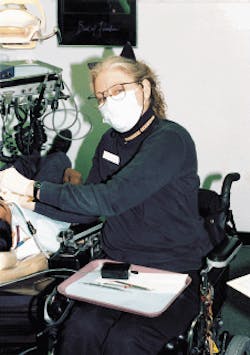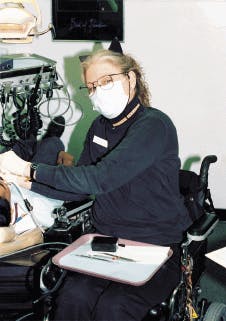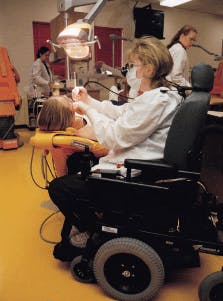Dont call them disabled; call them practicing hygienists!
The biggest professional problem these paraplegic hygienists faced was a hand control for the dental handpiece.
Cathy Hester Seckman, RDH
Walk out to the reception area to greet your first patient of the day. Seat her, reach for the X-ray head, take a set of bitewings, go to the darkroom, and develop them. Come back, roll out your stool, and step on the patient chair-adjusting control to raise the chair. During the prophy, use one rheostat for the ultrasonic unit and another for the handpiece. Step on the chair control once more to lower the chair, release the patient, and walk him or her back out to the reception area.
How simple is that? It isn`t simple at all for Michelle Smith, a hygienist in San Juan Capistrano, Calif., though Smith has more than 20 years of wet-fingered hygiene experience. For her, each of these steps requires forethought and specific equipment, because she is a paraplegic.
"I wasn`t too worried about staying in hygiene after my accident four years ago," Smith recalls. "I knew there were other practicing handicapped hygienists and dentists. My worry was how to find them and talk to them."
A friend of a friend remembered an acquaintance, Judy Baldry of Santee, Calif., a paraplegic hygienist who had worked from a wheelchair for 30 years. The two talked, and Smith was very encouraged.
"Judy is a pioneer," Smith says. "She`s really been down there in the trenches."
Baldry, a graduate of the University of Southern California, worked four years as a hygienist before she became paraplegic in 1966. After rehabilitation, she returned to hygiene and worked in various offices - even doing temp jobs - from 1967 until her retirement in 1998.
"It was hard getting jobs back then," Baldry says, "because so many offices were not handicapped-accessible." She worked in several offices where she couldn`t even get into the lab or the front office!
"Even as late as the 1980s, I went down to UCLA to take a couple of anesthesia classes, and the dental clinic didn`t even have a restroom I could use. Finally, they set something up and hung a curtain for a door."
Baldry decided that she wanted to be a hygienist in the eighth grade, "and I never wavered. I`ve always enjoyed hygiene and never burned out on it. Where I burned out was in looking for jobs. It was so traumatic at times because of inaccessibility."
Wheelchair hygienist Karen Vanderlaan of Ontario, Calif., also has battled inaccessibility in the workplace. Vanderlaan became a paraplegic in the 1980s, before her senior year of high school. She is paralyzed only from the knees down, but uses a wheelchair almost exclusively. "I can use crutches, but I hate them because they tie up my hands. With the wheelchair, my hands are free for whatever I need to do.
"When I interview for a job, I always look at accessibility. At one office where I worked just one day a week, I couldn`t get into the bathroom. I learned not to drink coffee on those mornings and I went home for lunch."
Vanderlaan doesn`t believe her co-workers view her as handicapped. "I`ve been hired at all of my jobs at the first interview, so I can`t see that it`s been a problem. I`m a licensed, experienced hygienist, so they must figure I`m capable. Sometimes people forget I`m in a chair. They`ll say, `Karen, come over here a minute ... oh, wait, I forgot!` No one treats me any differently."
Inaccessibility was only a minor problem for Smith in 1995. Her next step in trying to get back to work was to talk to her boss, Dr. Philip Potter, of San Clemente. He was willing to help, and his entire staff was very supportive and patient.
"I was delighted that she wanted to come back," Dr. Potter says. "Michelle had worked for me for a long, long time. She`s more than an employee; she`s a great person to be around! When she was injured, it was like having one of the family injured. I was despondent for months, when we literally didn`t know whether she would survive.When we knew she`d be able to come back to work, it was a time of joy for all of us."
There was some minor remodeling in the office. For instance, the foot controls for the sinks had to be removed. A bigger problem was the backlog of patients who were waiting for Smith`s return.
"Some of them just didn`t get their teeth cleaned," Dr. Potter remembers. "People were calling, asking if they could be the first ones on her schedule when she returned. We made sure the first ones were people who already knew her. When we went from there to appointing people she hadn`t seen, we would make sure they were aware she was in a wheelchair, but we don`t make a big deal of it anymore. We don`t even mention it to new people. Her demeanor, her personality, and her energy are such that she just puts them at ease.
"Michelle is an inspiration to all of us in the way she`s getting on with her life. Anytime any of us get bogged down with petty problems, all we have to do is see how strong Michelle is. We`re grateful she`s with us and that she can be an example. It`s a synergistic feeling. She gains by having our support, and we gain by being around such an inspirational person."
"We laugh a lot," Smith says. "I know it hasn`t been easy for them. I`ve banged up the office everywhere. The casters of the electric chair I use at work are wide, and I can`t always stop instantly. I`ve made a mark on the walls all around the office at about eight inches off the floor. Dr. Potter maintains a great attitude, though. He jokes that he has repairmen on permanent retainer for me."
The most important tool Smith needed upon returning to work was a hand control for her dental handpiece. When Baldry was first rehabilitated in 1966, the handpiece also was her main concern.
"First, I cut up a Midwest prophy handpiece and put a rubber band around it," Baldry recalls. I was supposed to push the rubber band for control, but it didn`t work. At the pedo office where I was working, there was a belt-driven handpiece with a big rheostat on the floor. We drilled a hole in the rheostat and dropped a bolt into it to hold the sliding foot control open." Then, with a cutoff switch hung from a hook on the chair, she could turn the handpiece on or off.
"It worked very well for me," she remembers. "It didn`t seem to matter that I couldn`t control the speed."
For awhile, Baldry also used a motor from a lab unit that she could hook up to either a handpiece or an ultrasonic unit. "I had an electrical box with a toggle switch on it, to switch the handpiece on and off. But it didn`t really work well."
In 1995, things were a lot easier for Smith. The State Department of Vocational Rehabilitation put her in touch with Vanderlaan, who told her about A-dec.
"There`s a company in Oregon," Smith explains, "that has developed a hand control. A-dec is a wonderful company. The president actually called me personally!
"I said, `You have 900 employees; why are you calling me yourself instead of having your secretary call me?` But he has a background in industrial arts, and he likes to speak to wheelchair hygienists to learn more about their needs. He`s always looking for ideas (see sidebar)."
With the hand control installed in her operatory, Smith was ready to go. She had an older, hand-controlled patient chair, and a daylight loader for X-rays. The only thing that really was a problem was her manual wheelchair.
"I knew other handicapped hygienists were working from a manual chair, and I thought I could do it. But it was just inevitable that I`d forget a prophy cup or tip or something, and then I would have to move after I`d gotten started."
Imagine Smith`s dilemma! She would have to unglove, move the chair by its wheels, get what she needed, maneuver back into place, and reglove. She worked that way for several months, until the State Department of Vocational Rehabilitation provided her with an electric wheelchair.
"That`s what the department does for us. Its whole purpose is to put us back to work, and they`re prepared to do anything in the way of providing equipment or retraining. I had to jump through a lot of hoops - and it took forever - but I`m very grateful to have the chair. All I have to do now is cover the joystick to maintain a sterile field."
Vanderlaan doesn`t see a problem with her manual wheelchair. "I always have a cover on the patient chair, so I take hold of that to push and pull myself around. I don`t have to touch the wheels of my own chair at all."
Back in the 1960s, Baldry didn`t have a problem with her manual chair at first, nor did her patients. "I switched to a power chair in 1991, and that was perfect timing, because the patients were starting to worry about AIDS and other diseases. All I had to do then was put a bag over the joystick."
Baldry worked in pedodontic offices for most of her career. "For my entire career, I worked from the eight o`clock position, with one elbow on the arm of the chair for support. Even when I started working on adults in the 1980s, it was no problem.
"X-rays, though," she says ruefully, "were not convenient. I only did one or two temp jobs where I had to take X-rays, and it was pretty much point and shoot. At most of the places where I`ve worked, there was an X-ray technician who could do them."
There also are a few hygiene duties Smith has had to give up, also. "I try hard to do only what I can do, and I don`t go beyond my limits because I don`t want to compromise my patients` care. I find a full-mouth series to be too difficult, because my room is so small. I also haven`t gone back to giving anesthesia." Because of the location of her spinal injury, her trunk muscles are not strong enough to hold her upright when her elbows are out away from her body, which is sometimes necessary for anesthetic delivery.
"I am a bit compromised, but I try not to let the patients know that."
Both Baldry and Smith knew what they were getting into. Both had been out of school and in the real world for several years before their accidents, and had a good idea about how things would have to work for them. But what if you were just starting out?
A 1987 graduate of Loma Linda University`s dental hygiene school, Vanderlaan didn`t encounter any serious difficulties learning to be a hygienist. "I always had wanted to do hygiene, probably because of all those years of braces. I talked to my orthodontist, my dentist, other hygienists, and none of them saw a problem with me doing hygiene from a chair. At school, they were very helpful. We figured out ways to do everything. It was a learning experience for them, also."
Heather Stork of Grand Rapids, Mich., was at the beginning of her second year of hygiene studies at Ferris State University in 1997 when she was involved in a car accident that left her a paraplegic. Though some of her physicians and therapists thought she should choose another career, Stork wanted to stick with hygiene. After investing in a full year of study, she felt she deserved to finish.
Dr. Marilyn Stolberg, director of Ferris State`s dental hygiene program, remembers the determination of everyone involved. "My first thought was not whether it could be done, but only how long it would take. I couldn`t see that the wheelchair was an issue, but I questioned whether she could be persistent enough. She was."
Stolberg, along with faculty member Deb Horlak and occupational therapist Ruth Ann O`Brien, got to work.
"We started with the obvious things," Stolberg said. "There were foot-controlled sinks in the clinic. We switched to sensor sinks. Heather converted to a power chair, so we could just bag her joystick. A-dec provided us with a hand-held rheo. Workplace problems aside, a wheelchair-bound person has other adaptations to make, just to get to the workplace. Vanderlaan, who grew up on a dairy farm, uses a pickup truck to drive back and forth to her jobs, which total four full days a week.
OThe truck has been lowered and has an extended cab and hand controls. I get myself into it first, then open the back door and pull the chair up into the back.O
Smith works three, five-hour days a week, driving to the office in an adapted minivan with a fold-down ramp and hand controls. She doesn?t even have to get out of her wheelchair to drive. She also keeps a busy schedule as the mother of Brent, 14, and Jordan, 12. Four years ago, she and her husband, Doug, were out in the desert with the boys, riding three-wheelers when she suffered the accident that would paralyze her from the waist down.
Smith?s extended family includes a quadriplegic, so she knew what to expect. OI think I was more prepared for the finality of life in a wheelchair. As a new paraplegic, you tend to get bombarded with hope, with people who say, OWe?ll find a cure for this, and you?ll walk again someday.? But I knew from experience just how permanent my paralysis would be.
OYou can whine and cry, but it?s not going to do you any good. You might as well get out there with your chin up. The experience in my family helped me to accept what happened to me. I feel lucky and blessed to have such a good support system in my husband, my family, my boss, everyone. It hasn?t been easy. I?ve tried hard at times to keep that chin up, and it?s very difficult.O
Like her job in hygiene, life itself is full of things Michelle can?t do anymore. But, in both her professional life and personal life, she has learned to do what she can and not worry about the rest.
OI can?t wind my mantel clock. I can?t make the bed very well, and I can?t clean my windshield,O she said. OBut, despite these inconveniences, I can still be productive in my home and in the workplace. My family keeps me very busy and fulfilled just being a wife and mother, but my job fills another dimension of my life with the confidence and compassion that only many years of being a health care provider can bring.
Michelle said she was grateful that she could still do her job well despite the spinal cord injury. She encourages other hygienists whose lives have been changed in a similar manner to network with each other. Readers interested interested in contacting Smith to share Otheir experience, knowledge, or questionsO can reach her at (949) 493-3519.
Cathy Seckman, RDH, is a frequent contributor to RDH. She is based in Calcutta, Ohio.
Hygienist Judy Baldry (now retired) is the cat`s meow in this Halloween 1993 picture. She used a syringe plastic to cover the joystick; the toggle on the tray was for the Cavitron. The toggle on the bracket is an on/off and speed control for the handpiece. Both the Cavitron and the handpiece had quick-release attachments to the unit. Judy also used a saliva ejector-hose extension so she could easily drape the saliva ejector on the patient`s right side.
Hygienist Heather Stork works on a patient at Ferris State University in Grand Rapids, Mich. Heather converted to a power wheelchair so the joystick could be bagged. She uses a hand-held rheostat and the ultrasonic unit was redesigned to be hand-colored. A cord is tied around the foot control on her patient chair, and she pulls it to raise and lower the chair. Heather graduated from the hygiene program in June 1999.
With a little help from my friends
The curious company president who called Michelle personally is Ken Austin of A-dec in Newburg, Ore. He developed the hand-control system that enabled handicapped dental personnel to work without a rheostat. He designed it back in the 1970s with his technical assistant, Paul Sturges.
"It all started," Austin explained, "with a dental student who was shot in the liquor store where he worked. It inspired us to work on this hand control. When I first had the idea, I actually was on an airplane with my son, explaining to him how it might be done. When I got home, we started working on it, and Paul and I developed it."
The A-dec hand control replaces the foot control, and is adapted to the dental unit that controls the handpiece. "There are dozens of them out there. It`s usually just by word-of-mouth that people hear of me."
To Austin`s knowledge, no one else makes a hand control. "There have been a number of attempts - quite a few, actually. Some people have even made one for themselves."
A-dec provides its controls at no charge to handicapped workers. "It`s just a service to people who need them," Austin says casually. Information about the hand controls is available at (503) 537-2777.
Austin`s unique talents have helped handicapped fishermen, as well. When a friend of his had a stroke, Austin developed an electric-operated, one-handed fishing reel. "We`ve built a thousand of those over the years, too. It`s brought a lot of new excitement to people with a disability. It`s something I like to do to help others."


